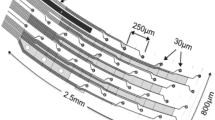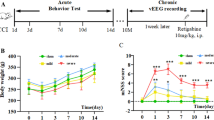Abstract
The effects of traumatic brain injury (TBI) on hippocampal long-term potentiation (LTP) and cellular excitability were assessed at postinjury days 2, 7, and 15. TBI was induced using a well-characterized central fluid-percussion model. LTP of the Schaffer collateral/commissural system was assessed in vivo in urethane-anesthetized rats. Significant LTP of the population excitatory postsynaptic potential (EPSP) slope was found only in controls, and no recovery to control levels was observed for any postinjury time point. Four measurement parameters reflecting pyramidal cell discharges (population spike) indicated that TBI significantly increased cellular excitability at postinjury day 2: (1) pretetanus baseline recording showed that TBI reduced population spike threshold and latency; (2) tetanic stimulation (400 Hz) increased population spike amplitudes to a greater degree in injured animals than in control animals; (3) tetanus-induced population spike latency shifts were greater in injured cases; and (4) tetanic stimulation elevated EPSP to spike ratios (E-S potentiation) to a greater degree in injured animals. These parameters returned to control levels, as measured on postinjury days 7 and 15. These results suggest that TBI-induced excitability changes persist at least through 2 days postinjury and involve a differential impairment of mechanisms subserving LTP of synaptic efficacy and mechanisms related to action potential generation
Similar content being viewed by others
References
Ascher P, Nowak L (1988) The role of divalent cations in the Nmethyl-gemd-aspartate responses of mouse central neurones in culture. J Physiol (Lond) 399: 247–266
Burke RE, Rudomin P (1977) Spinal neurons and synapses. In: Kandel ER (ed) The cellular biology of neurons (Handbook of physiology, sect 1, The nervous system, vol I, part 2) American Physiological Society, Bethesda, pp 877–944
Bliss TVP, Collingridge GL (1993) A synaptic model of memory: long-term potentiation in the hippocampus. Nature 361: 31–39
Chavez-Noriega LE, Bliss TVP, Halliwell JV (1989) The EPSP-spike (E-S) component of long-term potentiation in the rat hippocampal slice is modulated by GABAergic but not cholinergic mechanisms. Neurosci Lett 104: 58–64
Collingridge GL, Kehl SJ, McLennan HJ (1983) Excitatory amino acids in synaptic transmission in the Schaffer collateral-commissural pathway of the rat hippocampus. J Physiol (Lond) 334: 33–46
Delahunty TM (1992) Mild traumatic brain injury enhances muscarinic receptor-linked inositol phosphate production in rat hippocampus. Brain Res 594: 307–310
Dixon CE, Lyeth BG, Povlishock JT, Findling RL, Hamm RJ, Marmarou A, Young HF, Hayes RL (1987) A fluid percussion model of experimental brain injury in the rat. J Neurosurg 67: 110–119
Faden AI, Demediuk P, Panter SS, Vink R (1989) The role of excitatory amino acid receptors and NMDA receptors in traumatic brain injury. Science 244: 798–800
Hamm RJ, Dixon CE, Gbadebo DM, Singha AK, Jenkins LW, Lyeth BG, Hayes RL (1992) Cognitive deficits following traumatic brain injury produced by controlled cortical impact. J Neurotrauma 9: 11–20
Hamm RJ, O'Dell DM, Pike BR, Lyeth BG (1993) Cognitive impairment following traumatic brain injury: the effect of preand post-injury administration of scopolamine and MK-801. Brain Res Cog Brain Res 1: 223–336
Harris EW, Ganong AH, Cotman CW (1984) Long-term potentiation in the hippocampus involves activation of N-methyl-gemd-aspartate receptors. Brain Res 323: 132–137
Hayes RL, Jenkins LW, Lyeth BG, Balster RL, Robinson SE, Clifton GL, Stubbins JF, Young HF (1988) Pretreatment with phencyclidine, an N-methyl-gemd-aspartate antagonist, attenuates long-term behavioral deficits in the rat produced by traumatic brain injury. J Neurotrauma 5: 259–274
Hayes RL, Jenkins LW, Lyeth BG (1992) Neurotransmitter-mediated mechanisms of traumatic brain injury: acetylcholine and excitatory amino acids. J Neurotrauma [Suppl 1] 9: 189–200
Illes P (1986) Mechanisms of receptor-mediated modulation of transmitter release in noradrenergic, cholinergic, and sensory neurones. Neuroscience 17: 909–928
Jeffery KJ, Morris RGM (1993) Cumulative long-term potentiation in the rat dentate gyrus correlates with, but does not modify, performance in the water maze. Hippocampus 3: 133–140
Jenkins LW, Lyeth BG, Lewelt W, Moszynski K, Dewitt DS, Balster RL, Miller LP, Clifton GL, Young HF, Hayes RL (1988) Combined pretrauma scopolamine and phencyclidine attenuate posttraumatic increased sensitivity to delayed secondary ischemia. J Neurotrauma 5: 275–287
Katayama Y, Becker DP, Tamura T, Havda DA (1990) Massive increases in extracellular potassium and the indiscriminant release of glutamate following concussive brain injury. J Neurosurg 73: 889–900
Liu S, Lyeth BG, Hamm RJ (1994) Protective effect of galanin on behavioral deficits in experimental traumatic brain injury. J Neurotrauma 11: 73–82
Lyeth BG, Jenkins LW, Hamm RJ, Dixon CE, Phillips LL, Clifton GL, Young HF, Hayes RL (1990) Prolonged memory impairment in the absence of hippocampal cell death following traumatic brain injury in the rat. Brain Res 526: 249–258
Lyeth BG, Liu S, Hamm RJ (1993) Combined scopolamine and morphine treatment of traumatic brain injury in the rat. Brain Res 617: 69–75
Lyeth BG, Jiang JY, Delahunty TM, Phillips LL, Hamm RJ (1994) Muscarinic cholinergic receptor binding in rat brain following traumatic brain injury. Brain Res 640: 240–245
Lynch G, Staubli U (1991) Possible contributions of long-term potentiation to the encoding and organization of memory. Brain Res Rev 16: 204–206
McIntosh TK, Vink R, Soares H, Hayes R, Simon R (1989) Effects of the N-methyl-gemd-aspartate receptor blocker MK-801 on neurologic function after experimental brain injury. J Neurotrauma 6: 247–259
Miyazaki S, Katayama Y, Lyeth BG, Jenkins LW, De Witt DS, Goldberg SJ, Newlon PG, Hayes RL (1992) Enduring suppression of hippocampal long-term potentiation following traumatic brain injury in rat. Brain Res 585: 335–339
Miller LP, Lyeth BG, Jenkins LW, Oleniak L, Panchision D, Hamm RJ, Phillips LL, Dixon CE, Clifton GL, Hayes RL (1990) Excitatory amino acid receptor subtype binding following traumatic brain injury. Brain Res 526: 103–107
Panter SS, Faden AI (1992) Pretreatment with NMDA antagonists limits release of excitatory amino acids following traumatic brain injury. Neurosci Lett 136: 165–168
Reeves TM, Lyeth BG, Povlishock JT (1994) Time course of LTP deficits following moderate traumatic brain injury. Soc Neurosci Abstr 20: 425
Smith DH, Okiyama K, Thomas MJ, Claussen B, McIntosh TK (1991) Evaluation of memory dysfunction following traumatic brain injury using the Morris Water Maze. J Neurotrauma 8: 259–269
Taube JS, Schwartzkroin PA (1988) Mechanisms of long-term potentiation: EPSP/spike dissociation, intradendritic recordings, and glutamate sensitivity. J Neurosci 8: 1632–1644
Wilson RC, Levy WB, Steward O (1981) Changes in translation of synaptic excitation to dentate granule cell discharge accompanying long-term potentiation. II. An evaluation of mechanisms utilizing dentate gyrus dually innervated by surviving ipsilateral and sprouted crossed temporodentate inputs. J Neurophysiol 46: 339–355
Author information
Authors and Affiliations
Rights and permissions
About this article
Cite this article
Reeves, T.M., Lyeth, B.G. & Povlishock, J.T. Long-term potentiation deficits and excitability changes following traumatic brain injury. Exp Brain Res 106, 248–256 (1995). https://doi.org/10.1007/BF00241120
Received:
Accepted:
Issue Date:
DOI: https://doi.org/10.1007/BF00241120




